:::::::::::::::::::::::::::::::::::::::::::::::::::::::::::::::::::::::::::::::::::::::::::::::::::::
Picture Puzzles, Rebus Pictuers
hanji-e 江戸の判じ絵
Hanji-E, Rebus and Puzzle Pictures where a speciality of the SHARE 洒落, the witticism of Old Edo.
The paintings, when the words were spoken aloud, would make a new word or sentence.
You need to know your Japanese very well to read them. You use only the sound of each illustrated item to create a new one.
判じ絵の考案(掛け言葉、だじゃれ)で、読み手は書かれたアイコンの音だけで処理します.
:::::::::::::::::::::::::::::::::::::::::::::::::::::::::::::::::::::::::::::::::::::::::::::::::::::
This is quite a famous one.

suzu ni me ... suzume 雀
:::::::::::::::::::::::::::::::::::::::::::::::::::::::::::::::::::::::::::::::::::::::::::::::::::::
From The War
こんなものが慰問袋から出てきたら……脱力・脱糞・戦意喪失であろう

(答・わたしたちもはたらきます)
watakushi tachi mo hatarakimasu
http://www.tadanorih.hp.infoseek.co.jp/tondemo/tondemo11.htm
:::::::::::::::::::::::::::::::::::::::::::::::::::::::::::::::::::::::::::::::::::::::::::::::::::::
About Tobacco, from Hiroshige
kore o hanjite gorōjiro
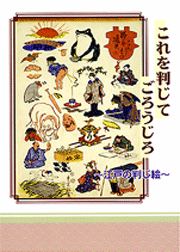
http://www.hokusai-paintings.com/index_kako/index200312.html
:::::::::::::::::::::::::::::::::::::::::::::::::::::::::::::::::::::::::::::::::::::::::::::::::::::
江戸名所 はんじもの(重宣)
Famous Places in Edo
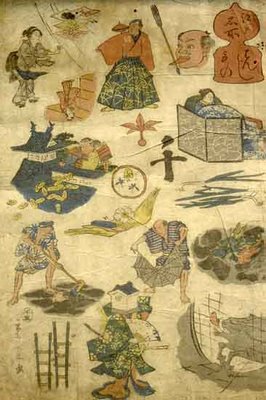
重宣 (1826-1869)は広重の弟子であり、
その後二代広重を襲名した人です。これは江戸の庶民の機知やユ-モアに呼応するもので、こんなところからも当時の一般庶民の生活ぶりが偲ばれます。寛政の改革で、美人画のなかに名前を書くのを禁じられたため「コマ絵」として、判じられもしました。もともと浮世絵は庶民のものでしたが、子供のおもちゃ絵からこういう謎解きもの、さらには今の新聞に代わるものまで発行されました。ただ庶民的であることが、その芸術性(代わる言葉が無くての表現ですが)を妨げるものでないと、私は思っています。浮世絵の中にある一要素をもって、全体の評価とするのは間違いだと思うからです。
さて、上記の作品は判じ物の中でもよく目にするものです。画面では少し皺がよってますが状態は良く直ぐ修復できそうで、値段だけでなく本当にラッキ-な出会いでした。江戸の地名を絵で描いてあるのですが、お判りでしょうか?
真ん中上部に描かれた、肩に独楽が乗っているのは「駒形 Komagata 」です。その右、舌に矢が刺さっている絵は「下谷 (shita ya ) 」ですね。他図も是非江戸の人に挑戦してください。どうしても判らない方は、「たばこと塩の博物館」を覗いて見てください、答えが紹介されております。
http://www.page.sannet.ne.jp/rokano28/ukiyoe/hanji.htm
Big Illustration
http://www.jti.co.jp/Culture/museum/tokubetu/eventApr99/hanji_1.html
:::::::::::::::::::::::::::::::::::::::::::::::::::::::::::::::::::::::::::::::::::::::::::::::::::::
閻魔大王判じ絵
Ema, the King of Hell
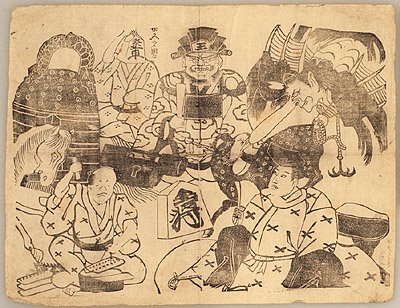
http://www.iii.u-tokyo.ac.jp/pblc-achv/digital_archive/ono_collection/contents/item.49.N029.html
:::::::::::::::::::::::::::::::::::::::::::::::::::::::::::::::::::::::::::::::::::::::::::::::::::::
判じ絵 十二ヶ月
The 12 Months of the Year
睦月(一月)から師走(十二月)までを判じ絵で染めております。どの絵がどの月か解いてみてください。

http://www.rienzome.co.jp/syumi/new/438.htm
:::::::::::::::::::::::::::::::::::::::::::::::::::::::::::::::::::::::::::::::::::::::::::::::::::::
【ダジャレ遺産:判じ絵】 Dajare of Edo
これは、人名である。
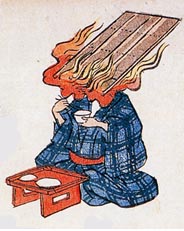
燃える戸がご飯を食べている、
つまり、「戸燃え御膳」 >> 巴御前である。
Tomoe Gozen
. Tomoe Gozen (巴御前) .
(1157?–1247) famous concubine of Minamoto no Yoshinaka.
... ...
食べ物だそうである。
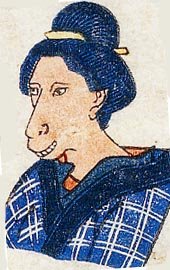
怪奇!馬女!! >> ではない。
馬に似ている。>>「馬似」>> ということで、うま煮
Uma-ni
... ...
生き物である。
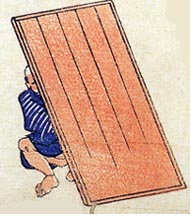
はずかしがりやさん。>> ではない。
このシャイボーイは戸の陰にいる。>>「戸陰」>>
ということで、トカゲ - Tokage
... ...
屁シリーズ、HE - farting
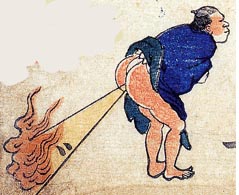
屁に火がついている。また、火の横にある横並びの点は、濁点を表している。
屁火+濁点 > なので、ヘビ ... Hebi, snake 蛇
to extinguish a fire HI/BI with a fart HE.
. WKD : Fart, farting (he 屁) .
... ...
屁シリーズ、その2 - farting
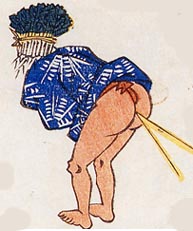
パーマヘアーをバンダナでまとめている、そんな八十年代アイドルみたいな奴が屁をしているわけではない。
こいつは、菜っ葉である。菜っ葉が屁。> 菜屁 ... Yasai
... ...
屁シリーズ、その3 - farting
今度は、どうも「屁」という音は関係ない。臭さをフューチャーしたらしい。表しているのは、今でも有名な地名。
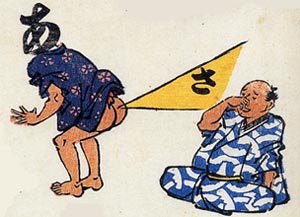
「あ」仮面と臭いフェチ。
ではもちろんない。これは、他のに比べて分かりやすかったかもしれない。
「あ」が出した「さ」が臭い。 >> あさ臭 >>
だから、浅草 Asakusa
一孟斎芳虎:画「新板はんじ物、虫」より
http://ameblo.jp/naiema/archive-200505.html
:::::::::::::::::::::::::::::::::::::::::::::::::::::::::::::::::::::::::::::::::::::::::::::::::::::
判じ物と判じ絵
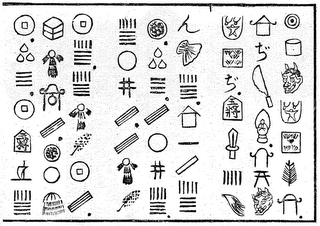
http://www.torito.jp/puzzles/puz_img/211_3b.gif
:::::::::::::::::::::::::::::::::::::::::::::::::::::::::::::::::::::::::::::::::::::::::::::::::::::
There is a book about these kind of picture puzzles.
Edo no Hanji-E 江戸の判じ絵
by 岩崎均史著
This is a kind of humor that will be hart to understand by non-Japanese.
体系化された初めての本ではないだろうか。版も大きいし、絵そのものも楽しめる。歌麿をはじめとして国貞、国芳など錚錚たる作家のはんじものもあれば、浮世絵作家が名を成す前に子供向けに作成したものなど多彩であり、手の込んだ刷り物が数多く収録されている。基本はことば遊びなので絵を見れば分かると言うわけにも行かず、やっぱりこのユーモアは外人には理解できないだろう。
http://www.book-navi.com/book/syoseki/edo.html
:::::::::::::::::::::::::::::::::::::::::::::::::::::::::::::::::::::::::::::::::::::::::::::::::::::
- quote -
Deciphering the place names, reading from the right to left:
1. め me (eye)・くろ kuro (black) → 目黒 Meguro
2. 四 yotsu (four)・矢 ya (arrow) → 四谷 Yotsuya
3. 鵜 u (cormorant, resting on top of a marker for advertising selling "colors")・絵の eno (two characters of the advertising stand) → 上野 Ueno
4. あ aka (red on top of umbrella)・傘 kasa (umbrella)・か ka (a character reading) → 赤坂 Akasaka
5. あ a (a character)・さ sa (a character)・臭(い) kusa(i) (smelly) → 浅草 Asakusa
6. 巣 su (spider nest)・(阿)弥陀 (a)mida (the Biddha)・川 kawa (river) → 隅田川 Sumidagawa river
7. 四 shi (four)・ば(葉に濁点) ba (leaf with dactiles on each leaf) → 芝 Shiba
8. 本 hon (book)・碁 go ("go" game with black and white chips)・鵜 u (cormorant, resting on top of a figure) → 本郷 Hongō/Hongou
9. かな kana (character)・すぎ sugi (ceder) → 金杉 Kanasugi
10. 煎り iri (roasting)・矢 ya (arrow) → 入谷 Iriya
11. 鷹 taka (howk)・縄 nawa (rope) → 高輪 Takanawa
12. つ(る) tsu(ru) (crane, shown only with its beak)・雉 kiji (pheasant) → 築地 Tsukiji
13. 火 hi (fire)・くら(わす) kurawasu (force feed) → 日暮里 Nippori, here read as (ひくらしの里 Hikurashi no sato, a sun-set village)
14. 大(きい) ō(kii) (large)・(こと)じ/琴柱 (koto)ji (bridge for koto string instrument) → 王子 Ōji
15. 本 hon (book, on the seated figure)・錠 jo (lock) → 本所 Honjo
16. 番 ban (to guard)・帳(面) chō(men) (account book)→ 番町 Banchō
17. 梅 ume (plum)・輪 wa (circle)・蚊 ka (mosquito) → 梅若 Umewaka (墨田区の旧町名, an old name in the Sumida Ward)
- source : National Diet Library -
Edo meisho hanjimono 江戸名所 はんじもの
:::::::::::::::::::::::::::::::::::::::::::::::::::::::::::::::::::::::::::::::::::::::::::::::::::::
Continue to
Puns and Word Plays, dajare 駄洒落 of Old Edo
:::::::::::::::::::::::::::::::::::::::::::::::::::::::::::::::::::::::::::::::::::::::::::::::::::::
[ . BACK to WORLDKIGO . TOP . ]
[ . BACK to DARUMA MUSEUM TOP . ]
:::::::::::::::::::::::::::::::::::::::::::::::::::::::::::::::::::::::::::::::::::::::::::::::::::::



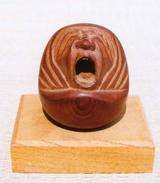







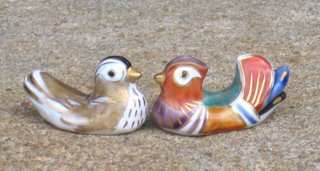
3 comments:
Gabi san,
I am shamefull why I don't know.
Maybe I am a man who like Dagyare!!
thank you for your sharing with interesting pictures.
sakuo.
Donji 鈍字 Kanji Riddles
http://darumasan.blogspot.jp/2006/08/donji-kanji-riddles.html
Utagawa Kuniyoshi, Damashie (歌川国芳のだまし絵)--
At first glance he looks fierce but he is actually a kind man;
「みかけハこハゐが とんだいゝ人だ」 弘化4年(1847年)
The expression "damashie だまし絵" is the Western equivalent of trompe-l'œi, eye-fooling-picture such as a number of eye-fooling paintings by Giuseppe Arcimboldo (1527 - July 11, 1593) and "Escaping Criticism" 「非難からの逃走」 by Pere Borrell del Caso (1835–1910), 1874.
.
https://www.google.co.jp/#q=+%E6%AD%8C%E5%B7%9D%E5%9B%BD%E8%8A%B3%E3%81%AE%E3%81%A0%E3%81%BE%E3%81%97%E7%B5%B5
.
Post a Comment